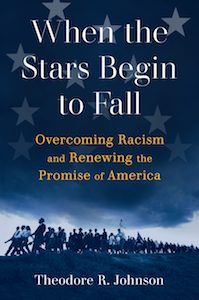
Theodore R. Johnson on Racism’s Existential Threat to the Promise of America
What Racial Hierarchy and Segregation Do to the Soul of a Nation
Our current disagreements, disparate perceptions, and differing approaches to race relations in the United States belie the danger in the ether: racism is an existential threat to America. This claim may seem alarmist and unwarranted at first blush. After all, if racism presents such peril to the country, then why is the United States still in existence? How has the nation managed to survive and grow stronger for nearly 250 years? Claiming that a difficult problem is an existential threat can be seen as a trite proclamation. However, regarding the question of whether racism is really capable of causing America to cease to exist, there can be no doubt of the seriousness of the inquiry or the certitude of the answer—it is yes.
When the end of America is discussed, our minds conjure scenes of calamity and chaos. We suspect that it would encompass a military coup against elected officials in Congress or the White House, with tanks rolling end to end down Pennsylvania Avenue, an economic collapse and the pillaging of the nation’s wealth by 21st-century robber barons, and urban areas swimming in broken glass as elected officials, the military and heavily armed police, and the people trade haymakers. It summons visions of Hollywood’s postapocalyptic doomsday movies wherein widespread violence carried out by and against the public fills ungoverned spaces, and the blatant trampling of constitutional rights is done for sport. And though some of these scenes have visited our towns and cities on occasion, the likelihood that the ultimate collapse of the United States would play out with such chaotic immediacy, and that racism would be the impetus, is quite low.
Instead, the fact that racism is an existential threat is less about the durability of the United States as a sovereign entity and more about the death of the American idea. The United States is a geographical polity with borders and a government, but America represents an aspiration and the embodiment of our principles, ideals, and beliefs. America is the Promise of citizens’ equality, liberty, and solidarity. Together, the United States of America is championed as a nation-state founded on a radical idea—a view espoused by both political parties.
In 2012, Barack Obama proclaimed during his reelection-night victory speech, “I believe we can keep the promises of our founders, the idea that if you’re willing to work hard… you can make it here in America if you’re willing to try.” When he was Speaker of the House, Republican Paul Ryan sought to comfort the public ahead of the contentious 2016 presidential election, saying, “America is the only nation founded on an idea—not an identity. That idea is the notion that the condition of your birth does not determine the outcome of your life.”
The nation’s history demonstrates that this idea was a vision of what is possible and not a description of reality. The enslavement of black people in a country founded on such an idea exposed a deep hypocrisy. The suffragist and civil rights activist Mary Church Terrell noted in 1906, “The chasm between the principles upon which this Government was founded, in which it still professes to believe, and those which are daily practiced under the protection of the flag, yawn so wide and deep.” But over time, belief in the idea—and the sacrifices of millions—delivered moral energy to the abolition of slavery, the installation of civil rights safeguards, and the proposition of a more perfect Union.
Racism, however, resists the American idea and the progress it demands. The idea can survive alongside declining racism so long as the nation inches away from racial hierarchy and toward equality. But once racial backsliding begins, America is in danger. And should the United States step into a double-armed embrace of racial revanchism, the life will be squeezed out of the American idea. The threat is a result of a basic truth: our founding principles of equality, liberty, and opportunity cannot coexist with racial hierarchy. We cannot believe that all of us are created equal while also subscribing to the view that white citizens are “more American” than black ones.
Racism undercuts our ability to ensure equal access to all the rights, protections, and responsibilities of citizenship. It suggests that there is an American caste system in which freedom in its fullest form is available only to some, while others are permitted to taste only a lesser, diluted version of it. Racism threatens to undermine the ideals at the foundation of our country—and at the core of what is supposed to unite us—and relegates them to little more than a ruse meant to placate those for whom the Promise remains out of reach and to justify the superior position of others who enjoy it in its fullness. The soul of America is steeped in aspirations set forth in our founding documents, and racism robs us of those ambitions. It laughs at the Dream, scoffs at the Promise, and chastises our professed values. And if the light ever goes out of our ideals, the potential of the United States will be diminished, devolving from a shining city on a hill to a gloomy burg on a bluff.
Racism, however, resists the American idea and the progress it demands.
This threat of racism has been clear and present since our inception. The nation’s first political leaders crafted the Declaration of Independence as a list of grievances that outlined the unjust practices of a distant monarch and explained why the colonies deemed it necessary to separate from Great Britain. An early draft contained a passage authored by Thomas Jefferson—himself a slaveholder—on the evils of the slave trade, but it was deleted at the insistence of representatives from South Carolina and Georgia, which owed much of their economy to an enslaved labor force and the human trafficking that fed it. Though many of the founders enslaved black people, and all of them benefited from the institution of slavery, some of them were not comfortable with the hypocrisy and expressed a desire for abolition.
John Jay wrote, “The honour of the States, as well as justice and humanity, in my opinion, loudly call upon them to emancipate these unhappy people. To contend for our own liberty, and to deny that blessing to others, involves an inconsistency not to be excused.” George Mason noted the threat slavery posed to the new nation, saying, “The augmentation of slaves weakens the state; and such a trade is diabolical in itself, and disgraceful to mankind.” And yet, though they recognized that slavery was incompatible with the newly declared self-evident truths, the nation’s framers allowed it to persist. They believed that a practice so inconsistent with the American idea could not endure and destiny would dissolve it. Patience, they implored, the ugly thing will die an ugly death on its own, as though Providence had already inscribed the incantation on America’s bedrock. As Jefferson wrote in his autobiography, “Nothing is more certainly written in the book of fate than that these people are to be free.” This is, perhaps, one of the earliest allusions to our country’s unofficial motto of blind faith: it’ll all work out somehow.
With national independence secured, the framers of the Constitution convened in the summer of 1787 to articulate the structure of our democratic government. But the issue of the status of black people reared its head again and almost sank the Union before it could set sail. James Madison explained that the greatest danger to the new nation was the conflict between the Northern and Southern states over slavery and congressional representation. When Maryland delegate Luther Martin argued that the slave trade was “inconsistent with the principles of the revolution and dishonorable to the American character,” he was met with fierce resistance led by South Carolina delegate John Rutledge.
Revered in the state, and its former governor, Rutledge, who enslaved black people, was an ardent supporter of the system and defended South Carolina’s interest in it throughout the Continental Congress. “Religion and morality have nothing to do with this question,” he said. “Interest alone is the governing principle with nations. The true question at present is whether Southern states shall or shall not be parties to the Union.” It was either slavery or the end of the Union.
The framers of the Constitution made their choice. “Great as the evil is,” lamented Madison, “a dismemberment of the union would be worse.” But Madison also recognized that this choice placed the nation at risk: “As nations cannot be rewarded or punished in the next world, they must be in this. By an inevitable chain of causes and effects Providence punishes national sins by national calamities.”
The nation descended into a catastrophic civil war just decades later, an occurrence prophesied by Alexis de Tocqueville when he wrote, “The most dreadful of all the evils that threaten the future of the United States arises from the presence of blacks on its soil.” The Union indeed broke in two, and the issue that split the nation was the status of black people and the racial order. The deadliest conflict to ever visit the United States consumed the countryside in a massive bloodletting that resulted in more than one million casualties.
Abraham Lincoln knew that the United States’ only chance of long-term survival and security required the nation to be one, that a balkanized continent would be susceptible to the same frequent internecine clashes that plagued Europe. Racism cleaved one set of states from the other—and one race of people from the other—and threatened the Union and, by extension, the entire American experiment. It is the only threat the United States has ever faced that succeeded in severing a part of the Union from the whole.
Writing to Horace Greeley, the editor of the New-York Tribune, in 1862, Lincoln declared, “My paramount object in this struggle is to save the Union, and is not either to save or destroy slavery… What I do about slavery, and the colored race, I do because I believe it helps to save the Union.” And yet, in Lincoln’s hands, the Declaration and the Constitution were transformed, evolving from pragmatic proclamations into national invocations. Though abolishing slavery was not the result of a moral epiphany or a divine inclination to champion racial equality, he trumpeted a spiritual call to arms to take the boldest action on race relations the nation has ever seen. He understood that the race question needed resolution if America was to survive. “In giving freedom to the slave, we assure freedom to the free—honorable alike in what we give, and what we preserve,” he told Congress in 1862. “We shall nobly save, or meanly lose, the last, best hope of the earth.”
It is the only threat the United States has ever faced that succeeded in severing a part of the Union from the whole.
Despite the sacrifice required to renew the American idea, including Lincoln’s martyrdom, within a decade racism regained its political prominence, preventing freedoms extended to black Americans from gaining a foothold. In a strategic move to ensure that the Ohio Republican governor Rutherford B. Hayes would win the presidential election of 1876, Republican leaders arranged a compromise with Democrats, whose nominee had won the popular vote, that would allow Hayes to take office via the Electoral College in exchange for the removal of federal troops from the Southern states. This effectively ended the Reconstruction period of civil rights reforms toward racial equality and ushered in an era of racial terrorism and rampant violence against black citizens. Torturous lynchings of black workers, adolescents, military veterans, small-business owners, and prospective voters over the next several decades provided a high-definition and three-dimensional illustration of just how little black Americans were valued and respected as fellow countrymen.
Lawful racial segregation became the order of the day, but prescient thinkers noted how it was incompatible with the American idea and, as such, unsustainable. In his famous 1896 dissent in the case of Plessy v. Ferguson, Justice John Harlan wrote, “The destinies of the two races in this country are indissolubly linked together, and the interests of both require that the common government of all shall not permit the seeds of race hate to be planted under the sanction of law.” He went on to say that if the nation permitted these racial divisions, it conferred an unconstitutional condition of racial inferiority on black Americans and would cause the highest degree of harm to the nation.
Decades later, the country approached another precipice. This time, domestic politics and national security interests brought about a new tranche of progressive race policy. President Harry Truman helped kick off a generation of transformational civil rights gains by desegregating the military in 1948. Giving a special address on racial equality to Congress, he described the features of structural racism and told the nation that “there is a serious gap between our ideals and some of our practices.” Truman believed closing the gap was essential to the nation’s stability and well-being, and to his election chances.
Two decades later and in the midst of the century’s biggest steps toward mitigating racism, President Lyndon Johnson told Congress that racial equality was “an issue that lays bare the secret heart of America itself.” He argued it presented a challenge “to the values and the purposes and the meaning of our beloved Nation,” and if we did not confront it head-on, “then we will have failed as a people and as a nation.”
So the threat racism poses to America has been well chronicled through the nation’s history by its founders, its elected leaders, and its stalwart citizens. From the Revolutionary Era through to the Civil Rights Movement, an appreciation existed of the danger racial hierarchy and inequality presented. But in the intervening years between the elections of Richard Nixon and Barack Obama, the less abrasive expressions of racial injustice and inequality gave us a false sense of comfort that the hardest part was behind us and that we would have a much easier go of it in the days ahead. Following Obama’s election, there were even claims that the United States had embarked on a post-racial period and that any lingering racial inequalities could be overcome with grit and elbow grease.
Martin Luther King, Jr., warned in a 1967 speech at Stanford University that while civil rights legislative gains were important, the real aim of genuine equality—to realize the Promise in its fullest form—would be a much more difficult struggle. He cautioned that even those who believe racism is wrong and black citizens’ rights should be granted and protected will balk at genuine equality because it requires national sacrifice and comes at a personal cost for all Americans. Nearly a year to the date after he shared these thoughts, he was pierced by the bullet of an assassin who could not bear to live in an America that extended its promises to black people. King died on a cool blue Memphis evening in April 1968, but the picture of America he painted one humid August afternoon in the nation’s capital five years prior remains framed and hung.
__________________________________

Excerpted from When the Stars Begin to Fall: Overcoming Racism and Renewing the Promise of America. Used with the permission of the publisher, Atlantic Monthly Press, an imprint of Grove Atlantic. Copyright © 2021 by Theodore R. Johnson.
Theodore R. Johnson
Theodore R. Johnson is a Senior Fellow and Director of the Fellows Program at the Brennan Center for Justice at the NYU School of Law, where he undertakes research on race, politics, and American identity. Prior to joining the Brennan Center, he was a National Fellow at New America and a Commander in the United States Navy, serving for twenty years in a variety of positions, including as a White House Fellow in the first Obama administration and as speechwriter to the Chairman of the Joint Chiefs of Staff. His work on race relations has appeared in prominent national publications across the political spectrum, including the New York Times Magazine, the Atlantic, the Washington Post, the Wall Street Journal, and the National Review, among others.












